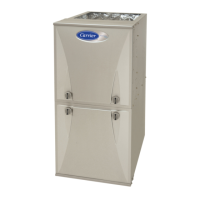5
CODES AND STANDARDS
Follow all national and local codes and standards in addition
to these instructions. The installation must comply with
regulations of the serving gas supplier, local building, heating,
plumbing, and other codes. In absence of local codes, the
installation must comply with the national codes listed below and
all authorities having jurisdiction.
In the United States and Canada, follow all codes and standards for
the following:
Safety
S US: Current edition of National Fuel Gas Code (NFGC) NFPA
54/ANSI Z223.1 and the Installation Standards, Warm Air
Heating and Air Conditioning Systems ANSI/NFPA 90B
S CANADA: Current edition of National Standard of Canada,
Natural Gas and Propane Installation Code (NSCNGPIC)
CAN/CSA B149.1
General Installation
S US: NFGC and the NFPA 90B. For copies, contact the National
Fire Protection Association Inc., Batterymarch Park, Quincy,
MA 02269; or for only the NFGC contact the American Gas
Association, 400 N. Capitol, N.W., Washington DC 20001
S CANADA: NSCNGPIC. For a copy, contact Standard Sales,
CSA International, 178 Rexdale Boulevard, Etobicoke
(Toronto), Ontario, M9W 1R3, Canada
Combustion and Ventilation Air
S US: Section 9.3 of the current edition of NFPA54/ANSI Z223.1
Air for Combustion and Ventilation
S CANADA: Part 8 of the current edition of CAN/CSA B149.1,
Venting Systems and Air Supply for Appliances
Duct Systems
S US and CANADA: Air Condit ioning Contr actors Association
(ACCA ) Ma nual D, Sheet Met a l and Air Conditioning Contractor s
National Association (SMACNA), or American Society of Heating,
Refrigerat ion, and Air Conditioning Engine ers (ASHRAE)
Fundam entals Handbook
Acoustical Lining and Fibrous Glass Duct
S US and CANADA: Cu rrent edition of SMACNA, NFPA 90B as
tested by UL Standard 181 for Class I Rigid Air Ducts
Gas Piping and Gas Pipe Pressure Testing
S US: Current edition of NFP A 54/ANSI Z223.1 NFGC; Chapte rs
5, 6, 7, and 8 and nat i onal plumbing codes.
CANADA: Curre nt edition of CAN/CSA--B149. 1, Parts 4, 5, 6,
and 9.
In the state of Massachusetts:
S This product must be ins tall ed by a li cens ed pl um ber or gas fitter.
S When flexible connectors are used, the maximum length shall
not exceed 36 in. (914 mm).
S W hen lever type gas shutoffs ar e used they sha ll be T--ha ndl e type.
S The use of copper tubing for gas piping is not approved by the
state of Massachusetts.
Electrical Connections
S US: Current edition of National Electrical Code (NEC) NFPA
70.
S CANADA: Current edition of Canadian Electrical Code CSA
C22.1
Condensate Drain Connection
S US: Current edition of National Standard Plumbing Code,
Section 8.7.
S Canada: Current edition of National Plumbing Code of Canada.
ELECTROSTATIC DISCHARGE (ESD)
PRECAUTIONS PROCEDURE
FURNACE RELIABILITY HAZARD
Failure to follow this caution may result in unit component
damage.
Electrostatic discharge can affect electronic components.
Take precautions during furnace installation and servicing
to protect the furnace electronic control. Precautions will
prevent electrostatic discharges from personnel and hand
tools which are held during the procedure. These
precautions will help to avoid exposing the control to
electrostatic discharge by putting the furnace, the control,
and the person at the same electrostatic potential.
CAUTION
!
1. Disconnect all power to the furnace. Multiple disconnects
may be required. DO NOT TOUCH THE CONTROL
OR ANY WIRE CONNECTED TO THE CONTROL
PRIOR TO DIS CHARGING YOUR BODY’S
ELECTROSTATIC CHARGE TO GROUND.
2. Firmly touch the clean, unpainted, metal surface of the fur-
nace chassis which is close to the control. Tools held in a
person’s hand during grounding will be satisfactorily dis-
charged.
3. After touching the chassis, you may proceed to service the
control or connecting wires as long as you do nothing to
recharge your body with static electricity (for example; DO
NOT move or shuffle your feet, do not touch ungrounded
objects, etc.).
4. If you touch ungrounded objects (and recharge your body
with static electricity), firmly touch a clean, unpainted metal
surface of the furnace again before touching control or
wires.
5. Use this procedure for installed and uninstalled (ungroun-
ded) furnaces.
6. Before removing a new control from its container, discharge
your body’s electrostatic charge to ground to protect the
control from damage. If the control is to be installed in a
furnace, follow items 1 through 4 before bringing the con-
trol or yourself in contact with the furnace. Put all used and
new controls into containers before touching ungrounded
objects.
7. An ESD service kit (available from commercial sources)
mayalsobeusedtopreventESDdamage.
ACCESSORIES
See Product Data Sheet for a list of accessories for this product.

